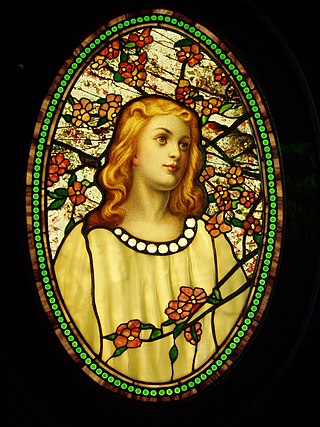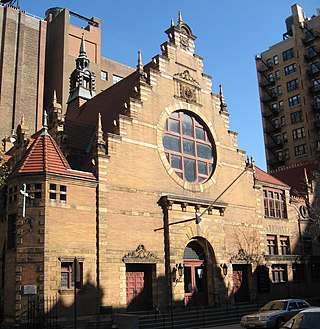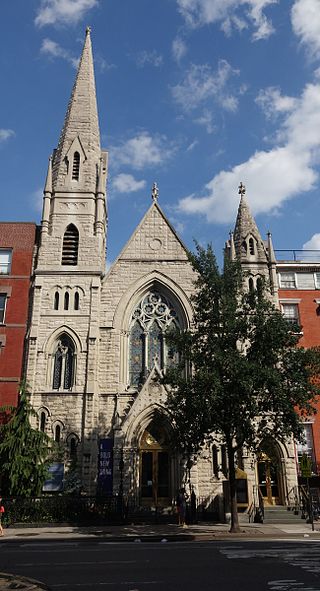
Louis Comfort Tiffany was an American artist and designer who worked in the decorative arts and is best known for his work in stained glass. He is associated with the art nouveau and aesthetic art movements. He was affiliated with a prestigious collaborative of designers known as the Associated Artists, which included Lockwood de Forest, Candace Wheeler, and Samuel Colman. Tiffany designed stained glass windows and lamps, glass mosaics, blown glass, ceramics, jewellery, enamels, and metalwork. He was the first design director at his family company, Tiffany & Co., founded by his father Charles Lewis Tiffany.

Flushing is a neighborhood in the north-central portion of the New York City borough of Queens. The neighborhood is the fourth-largest central business district in New York City. Downtown Flushing is a major commercial and retail area, and the intersection of Main Street and Roosevelt Avenue at its core is the third-busiest in New York City, behind Times Square and Herald Square.

The Flushing–Main Street station is the eastern terminal on the IRT Flushing Line of the New York City Subway, located at Main Street and Roosevelt Avenue in Downtown Flushing, Queens. It is served by the 7 local train at all times and the <7> express train during rush hours in the peak direction.

The Flushing Remonstrance was a 1657 petition to Director-General of New Netherland Peter Stuyvesant, in which some thirty residents of the small settlement at Flushing requested an exemption to his ban on Quaker worship. It is considered a precursor to the United States Constitution's provision on freedom of religion in the Bill of Rights.

The Arlington Street Church is a Unitarian Universalist church across from the Public Garden in Boston, Massachusetts. Because of its geographic prominence and the notable ministers who have served the congregation, the church is considered to be among the most historically important in American Unitarianism and Unitarian Universalism. Completed in 1861, it was designed by Arthur Gilman and Gridley James Fox Bryant to resemble James Gibbs' St. Martin-in-the-Fields in London. The main sanctuary space has 16 large-scale stained-glass windows installed by Tiffany Studios from 1899 to 1930.

St. Michael's Church is a historic Episcopal church at 225 West 99th Street and Amsterdam Avenue on Manhattan's Upper West Side in New York City. The parish was founded on the present site in January 1807, at that time in the rural Bloomingdale District. The present limestone Romanesque building, the third on the site, was built in 1890–91 to designs by Robert W. Gibson and added to the National Register of Historic Places in 1996.

The Marble Collegiate Church, founded in 1628, is one of the oldest continuous Protestant congregations in North America. The congregation, which is part of two denominations in the Reformed tradition—the United Church of Christ and the Reformed Church in America—is located at 272 Fifth Avenue at the corner of West 29th Street in the NoMad neighborhood of Manhattan in New York City. It was built in 1851–54 and was designed by Samuel A. Warner in Romanesque Revival style with Gothic trim. The façade is covered in Tuckahoe marble, for which the church, originally called the Fifth Avenue Church, was renamed in 1906.

Tiffany glass refers to the many and varied types of glass developed and produced from 1878 to 1929-1930 at the Tiffany Studios in New York City, by Louis Comfort Tiffany and a team of other designers, including Clara Driscoll, Agnes F. Northrop, and Frederick Wilson.

The Park Avenue Christian Church is a joint Disciples of Christ and United Church of Christ church located at 1010 Park Avenue at 85th Street, on the Upper East Side of Manhattan, in New York City, New York, in the United States. The Rev. Kaji S. Douša has served as Senior Pastor since 2016. She is the first woman and the first Black woman to be called to this role, the second African-American after the Rev. Alvin Jackson, Pastor Emeritus.

The First Hungarian Reformed Church of New York is located on East 69th Street in the Upper East Side of the New York City borough of Manhattan. It is a stucco-faced brick building, completed in 1916 in a Hungarian vernacular architectural style, housing a congregation established in 1895.

Fifth Avenue Presbyterian Church is a Presbyterian Church (U.S.A.) church in New York City. The church, on Fifth Avenue at 7 West 55th Street in Midtown Manhattan, has approximately 2,200 members and is one of the larger PCUSA congregations. The church, founded in 1808 as the Cedar Street Presbyterian Church, has been at this site since 1875.

The Old Dutch Church, officially known as the First Reformed Protestant Dutch Church of Kingston, is located on Wall Street in Kingston, New York, United States. Formally organized in 1659, it is one of the oldest continuously existing congregations in the country. Its current building, the fifth, is an 1852 structure by Minard Lafever that was designated a National Historic Landmark in 2008, the only one in the city. The church's 225-foot (69 m) steeple, a replacement for a taller but similar original that collapsed, makes it the tallest building in Kingston and a symbol of the city.

Roosevelt Avenue and Greenpoint Avenue are main thoroughfares in the New York City boroughs of Queens and Brooklyn. Roosevelt Avenue begins at 48th Street and Queens Boulevard in the neighborhood of Sunnyside. West of Queens Boulevard, the road is named Greenpoint Avenue and continues through Sunnyside and Long Island City across the Greenpoint Avenue Bridge into the borough of Brooklyn, terminating at WNYC Transmitter Park on the East River in the neighborhood of Greenpoint. Roosevelt Avenue goes through Woodside, Jackson Heights, Elmhurst, Corona, Flushing Meadows–Corona Park and Flushing. In Flushing, Roosevelt Avenue ends at 156th Street and Northern Boulevard.

The West End Collegiate Church is a church on West End Avenue at 77th Street on Manhattan's Upper West Side. It is part of The Collegiate Reformed Protestant Dutch Church in the City of New York, the oldest Protestant church with a continuing organization in America. The Collegiate Church of New York is dually affiliated with the United Church of Christ (UCC) and the Reformed Church in America (RCA). The West End Collegiate Church is listed on the U.S. National Register of Historic Places.

Hyde Park Dutch Reformed Church is located on US 9 in the center of Hyde Park, New York, United States, just north of the post office and the junction with Market Street at the center of town. It is a complex of several buildings on a 2-acre (0.81 ha) lot.

The Flatbush Reformed Protestant Dutch Church, also known as the Flatbush Reformed Church, is a historic Dutch Reformed church – now a member of the Reformed Church in America – at 890 Flatbush Avenue in the Flatbush neighborhood of Brooklyn, New York City. The church complex consists of the church, cemetery, parsonage and church house.

St. Nicholas Collegiate Reformed Protestant Dutch Church was a Reformed Protestant Dutch church in Midtown Manhattan, New York City, which was Manhattan's oldest congregation when it was demolished in 1949. The church was on the northwest corner of Fifth Avenue and 48th Street near Rockefeller Center. The church was built in 1872 to Gothic Revival designs in brownstone by architect W. Wheeler Smith and "distinguished by an elegantly tapered spire that, according to John A. Bradley in The New York Times, 'many declare…the most beautiful in this country.'" The congregation dated to 1628.

The Middle Collegiate Church is a dually aligned United Church of Christ and Reformed Church in America church located at 112 Second Avenue between 6th and 7th Streets in the East Village neighborhood of Manhattan, New York City.

Knox-Metropolitan United Church stands on Lorne Street at Victoria Avenue across from Victoria Park in downtown Regina, Saskatchewan, Canada. It is the current manifestation of Presbyterian and Methodist congregations that date back to "worship services in both traditions…in 1882."

Agnes Northrup was an American glass artist. She is best known for her design work for Louis Comfort Tiffany and for work in iridescent glass.
























